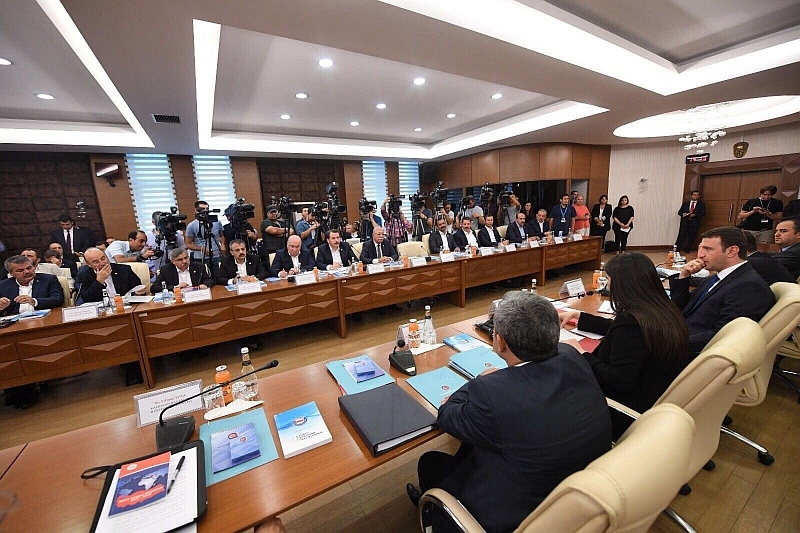
In this post, we will see MESO (Multiple Equivalent Simultaneous Offers) technique in application during labor talks in Turkey, and explore its function in win-win negotiations.
Turkish government and labor unions kicked off negotiations over salary raises for the coming two years last Tuesday. Labor and Social Security Minister Julide Sarieroglu chairs the meetings, where salary raises will be discussed for around 3.2 million government employees and 1.9 million pensioners in Turkey. Representatives from government employers committee, Memur-Sen (Union of white-collar government employees), Kamu-Sen (Union of blue-collar goverment employees) and KESK (Confederation of Public Sector Trade Unions) will be attending the talks.
Building rapport in the beginning is critical for a successful negotiation. In her opening speech of discussions, Ms. Sarieroglu said “even if we are on different sides of the table with the delegations, we are not opponents, but we are on the same ship. Here is also a platform of empathy where government employees better understand each other. In the end, problems of government employees are being solved one by one.” She also added that the government would not disregard the expectations of over 5 million government employees and pensioners, but they had to take into consideration also the economic conditions in the country and in the world.


Proposals made by labor unions
On the first session of negotiations, labor unions came up with different proposals. KESK made the most straight-forward proposal and asked only to raise minimum salary excluding side benefits up to 3.450 Turkish Liras.
Kamu-Sen came up with a more sophisticated proposal. Here is a summary of what they asked from the government:
- 1 January 2018: +10% adjustment for inflation + 3% adjustment for economic growth and welfare + flat increase of 150 Turkish Liras
- 1 July 2018: +10% adjustment for inflation
- 1 January 2019: +8% adjustment for inflation + 3% adjustment for economic growth and welfare + flat increase of 150 Turkish Liras
- 1 July 2019: +8% adjustment for inflation
Just to provide some context, let me add that inflation in Turkey is expected to be around 10% by the end of 2017. So Kamu-Sen’s opening proposal perhaps fits into “aim high” strategy, which we may elaborate in another post later.
The most interesting opening came from Memur-Sen (Union of White-collar Government Employees), which put on the negotiation table three alternative proposals at the same time and asked government representatives to choose one of them:
- First alternative
- 1 January 2018: 10% increase
- 1 July 2018: 6% increase
- 1 January 2019: 10% increase
- 1 July 2019: 8% increase
- Second alternative
- 1 January 2018: 7% increase + flat increase of 75 Turkish Liras
- 1 July 2018: 7% increase
- 1 January 2019: 7% increase + flat increase of 75 Turkish Liras
- 1 July 2019: 7% increase
- Third alternative
- 1 January 2018: 6% increase + improvements on side payments and compensations
- 1 July 2018: 6% increase
- 1 January 2019: 10% increase
- 1 July 2019: 8% increase
Memur-Sen has used Multiple Equivalent Simultaneous Offers (MESO) technique in their opening proposal.
MESO technique in detail
The principle behind MESO is, simply put, make multiple offers which are mutually equal in your mind. By doing this, one can better understand one’s partner in a negotiation—his or her interests, expectations, etc.
The acronym MESO is used because “of its etymological origins in Greek to mean both ‘combining form’ and ‘middle’, suggesting a balance between states. MESOs allow negotiators to collect and integrate complex information, to successfully combine aggressiveness with cooperation, persistence with flexibility. This technique allows negotiators to set the state for the negotiations, to play detective, and to achieve outcomes that would otherwise be difficult to capture.” (1)
Victoria Husted Medvec and Adam D. Galinsky of Northwestern University argued that, in negotiations involving many issues, you can create a great deal of value by making MESOs. MESO negotiation techniques for negotiators include creating value at the bargaining table by identifying multiple proposals of equal value and presenting them to your counterpart simultaneously. By making trade-offs across issues, parties can obtain greater value on the issues that are most important to them. But how can you be sure you’re making the right offer? This strategy entails identifying several proposals that you value equally and presenting them to the other side. By making multiple offers, the theory goes, you appear more flexible, collect information about the other side’s preferences based on which offer she likes best, and increase the odds of reaching agreement.
Harvard Business School professor Max H. Bazerman proposes to ask which one of the offers your counterpart likes the best, if he or she refuses all of them. “Your counterpart’s preference for a specific offer should give you a strong clue about where you might find value-creating, win-win trades and generate mutual gain.”
The only cost of this strategy is that it requires thorough preparation prior to the negotiation. There may be some things that are important to you that may be less important to your counterpart. You need to identify and prioritize issues, estimate their weights (relative value) to both parties. You need to identify different likely outcomes for each issue, then set one as the standard, and set relative values of the others. Assigning point values is one way of determining whether one package is, on the whole, more appealing than another.
MESO is only beneficial if the party offering the multiple offers is honest. You will have to reveal some of your interests in MESO, but in return you will learn interests of your counterpart. MESO is an effective tool to be used especially in the information exchange phase of negotiations, where value creating takes place, therefore it is critical to win-win negotiations.
Key learnings
- Consider using MESO technique if there are more than one variables under discussion.
- Make thorough preparation for assessing value of variables
- Be honest and do not be afraid of revealing some of your own interests
- Create at least three equivalent offers. These offers should have more or less equal value to you.
- Ask which one of the offers your counterpart likes the best, if he or she refuses all of them
- Look for clues about where you might find value-creating, win-win trades and generate mutual gain
Footnotes:
(1): Medvec, Victoria Husted; Geoffrey J. Leonardelli; Adam D. Galinsky; Aletha Claussen-Schulz. “Multiple Equivalent Simultaneous Offers”
